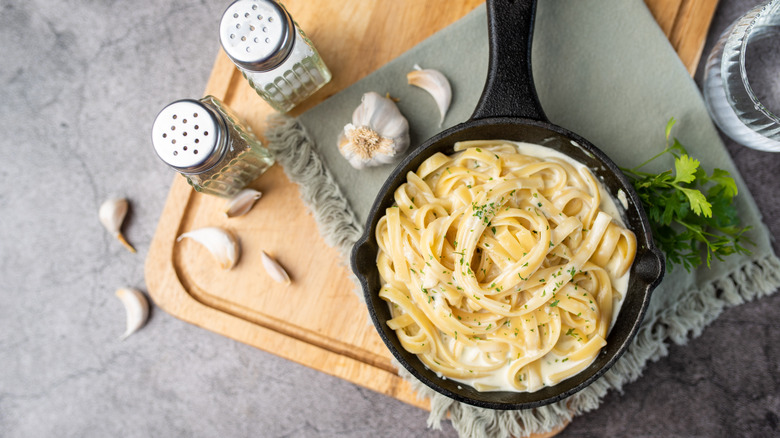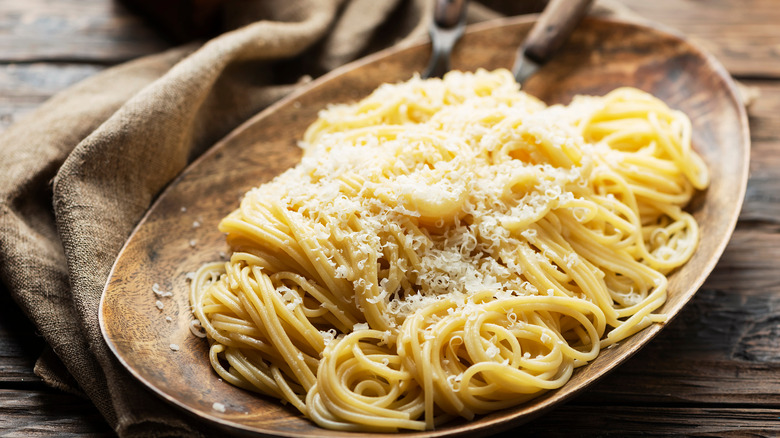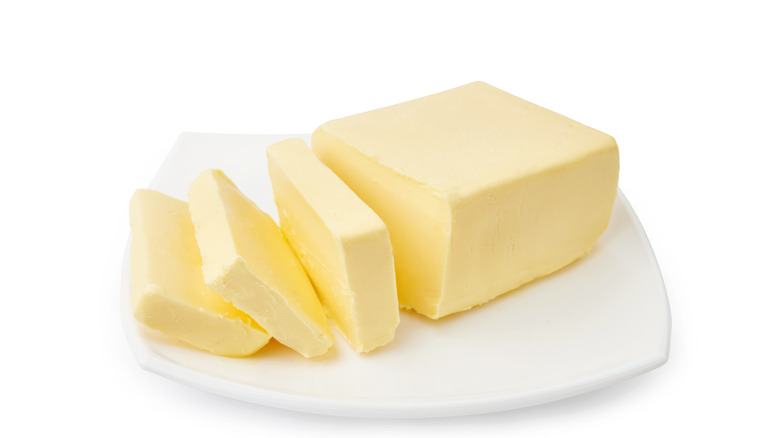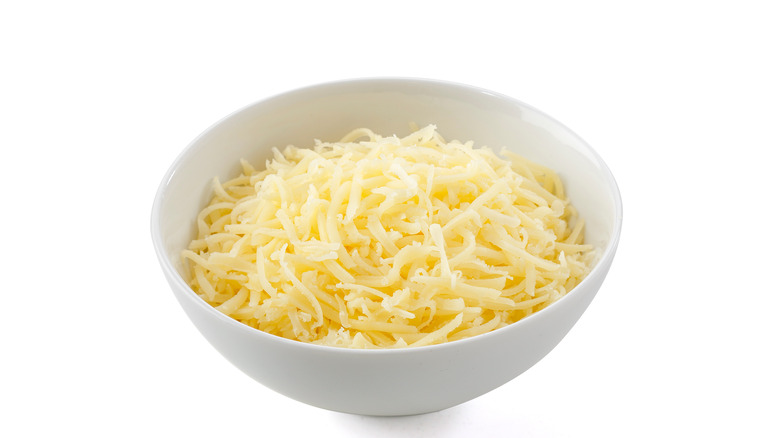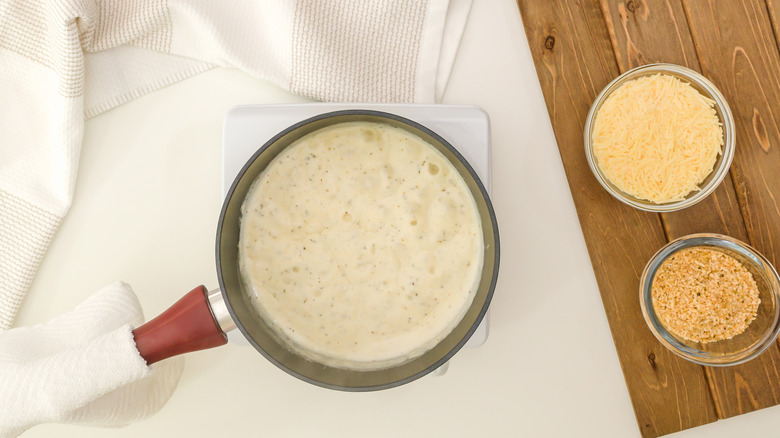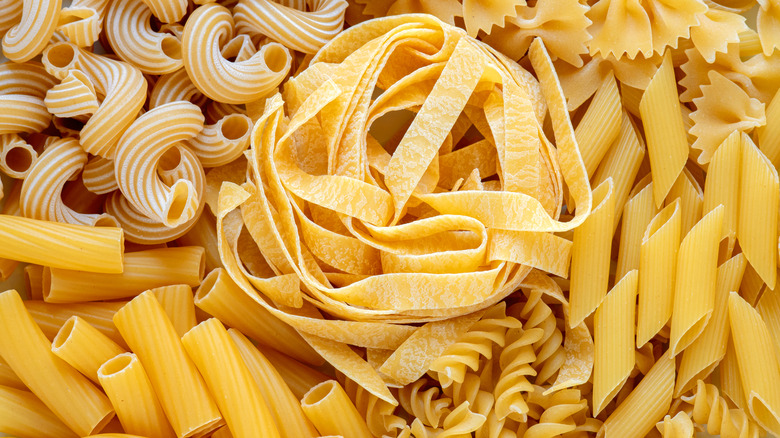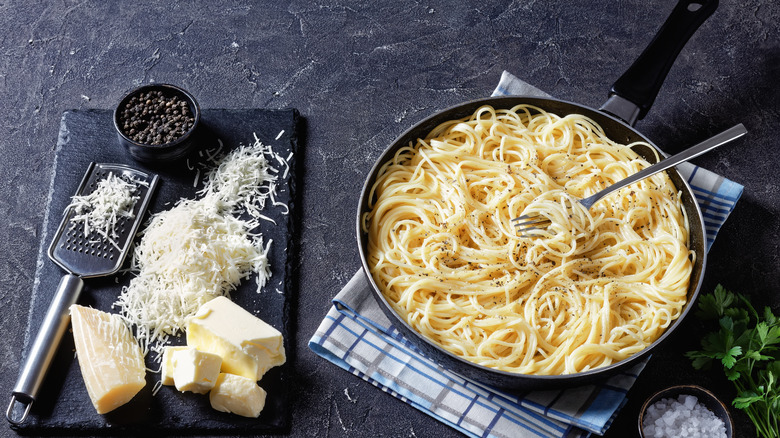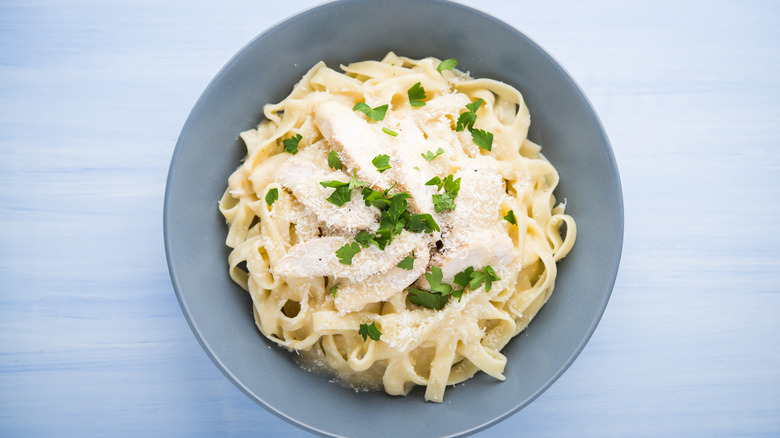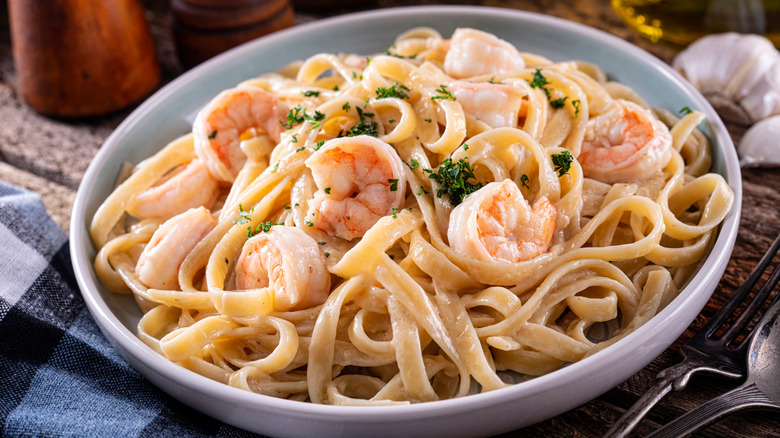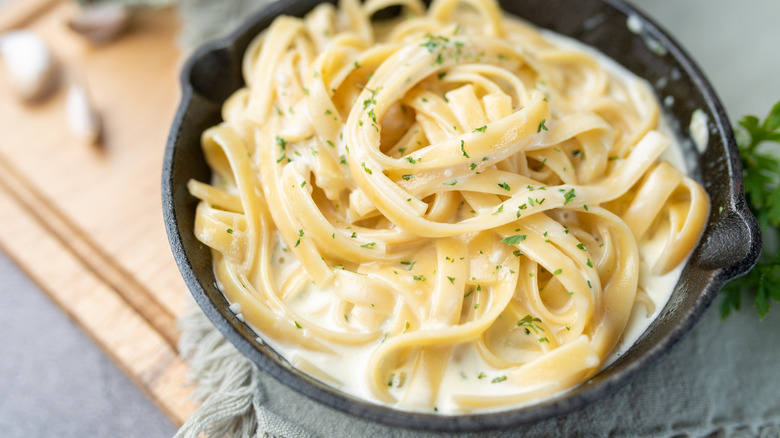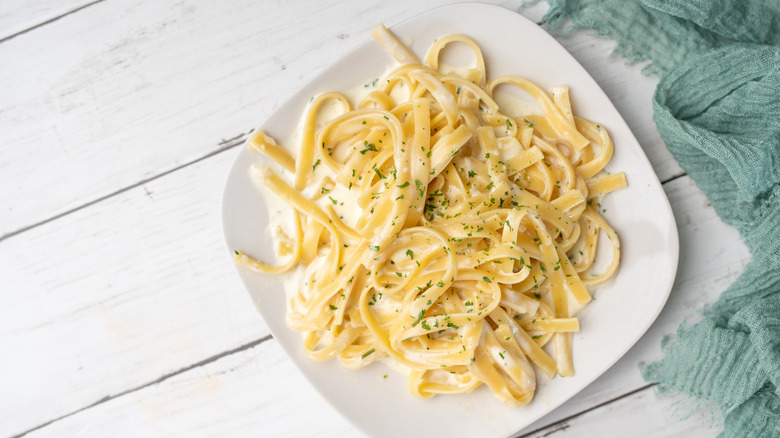Mistakes You're Making With Your Alfredo Sauce
The combination of fettuccine pasta and Alfredo sauce has become an American standard, but there's more to this popular pairing than meets the eye. Though rooted in Italy, the original recipe for this decadent dish is a simpler affair compared to the version you'll likely be served in the United States. Italian-American interpretations — the likes of which you'll find at your local Olive Garden and beyond — are far richer than the Italian stalwart. These recipes often start with a cream base and add loads of other flavors, ranging from black pepper to garlic and even Cajun spices. Some even top the finished pasta with grilled chicken or shrimp!
Whether you're going for the classic Roman version or for the American iteration of Alfredo sauce, there are quite a few wrong turns you can make, ranging from adding the wrong ingredients to using the wrong pan. If your goal is for a successful, silky sauce, then we're here to help. These are the mistakes many people make when crafting their Alfredo sauce.
Assuming Alfredo sauce is Italian
Like spaghetti and meatballs or chicken parmesan, fettuccine Alfredo is a staple of "Italian" cuisine in the U.S. that would likely seem foreign to those actually hailing from The Boot.
Fettuccine Alfredo got its start as a fairly commonplace combo of butter, Parmigiano-Reggiano, and pasta. Known locally as fettuccine al burro (literally: fettuccine with butter), the dish was ostensibly invented by a Roman restaurateur, Alfredo di Lelio, to tempt his ailing wife to eat. According to Disgraces on the Menu, the dish became popular in America in the early 20th century after di Lelio, whose restaurant was popular with American tourists visiting the Italian capital, served it to Hollywood stars Mary Pickford and Douglas Fairbanks when they were visiting the city on their honeymoon. They fell for the dish, introduced it to their friends back home, and the rest is history.
Once in the U.S., this common pasta dish evolved to become a richer sauce made with a cream base. And it's only in the U.S. that the dish bears Alfredo's moniker; the original, authentic sauce is so simple and commonplace that in Italy, it doesn't really need a name!
Sticking with the Italian-American version
As much as we enjoy the ultra-rich Americanized take on Alfredo sauce, going the Roman route will also yield tasty and decadent results. This simpler, butter-based pasta sauce more than holds its own when compared with the cream version that we tend to focus on in the U.S. According to Serious Eats, you'll need to use an entire stick of butter per pound of pasta in order to get the silky sauce you crave. While it won't have quite the thickness of, say, the Olive Garden version that many Americans are accustomed to, it will be absolutely delicious. It's no wonder people get so defensive regarding the "authentic" fettuccine Alfredo (or rather, fettuccine al burro).
Of course, we won't stand on ceremony! While the original Roman version excels even though its so simple, there is a reason the Italian-American Alfredo sauce, with its laundry list of ingredients, is so beloved.
Using the wrong cheese
There's a whole host of Alfredo sauce recipes out there using everything from blue cheese to goat cheese to cheddar. But let's be clear on one thing: A true Alfredo sauce uses one cheese, and that's Parmigiano-Reggiano; anything else, while certainly delicious, is just a cheese sauce. There are a few deviations, however, that bear mentioning. While not traditional, some versions of Alfredo use mild-mannered cream cheese to thicken and flavor the sauce, making it creamier without the addition of heavy cream.
Others opt for a different hard Italian cheese, swapping Parmesan for sheep's milk pecorino Romano, which has a funkier flavor. While certainly delicious, pecorino is actually the base of cacio e pepe, a similar, ultra-simple cheese sauce from Rome made with a heaping helping of aromatic black pepper. But since we're talking Alfredo, Parmesan is the only cheese you should really be inviting into your recipe.
Using pre-grated Parmesan in your Alfredo sauce
Parmesan cheese is the star ingredient of Alfredo sauce, so you want to make sure you use the good stuff. Stick with the authentic Parmesan from Italy, not the American pre-grated stuff found in a can or tub.
The reason why is twofold: First, as a key flavor agent of your sauce, you want to make sure you're getting all the rich, nutty flavor of true Parmesan. But equally important is the texture discrepancy between the two. Pre-grated Parmesan is usually coated with cornstarch or another nonstick agent (like cellulose — aka wood pulp ... ick) to help keep it from clumping in the jar or container. But in a sauce, you want the Parmesan to come together. Cornstarch-coated Parm can result in a stringy or clumpy sauce that never fully emulsifies. And if it's not true Parmigiano-Reggiano, the cheese in the container, according to ScienceDirect, may be at least partially acid-coagulated instead of being rennet-coagulated (like non-melting paneer, for example). This will keep it from melting nicely into the Alfredo sauce.
Using cold cream in your Alfredo sauce
While some eschew the use of cream entirely in Alfredo sauce, if you do go for the Italian-American play on the classic, there are a few errors that will make it far from the lovely, luscious sauce of your dreams. One such mistake, per Home Made Interest, is using straight from the refrigerator to make your Alfredo sauce. When added to the hot pasta, cold cream risks separating, giving you a split sauce rather than a silky smooth one. To avoid this unfortunate result, most Alfredo sauce recipes call for heating the cream in a small saucepan, or even in the microwave, before adding the cheese.
Combining hot ingredients like this has a number of benefits. Adding perfectly cooked hot pasta to a hot sauce is a quicker endeavor than adding a cold sauce to hot pasta and waiting for the sauce to heat up. You also run a far lower risk of overcooking your pasta so that it's mushy rather than al dente. But specifically in the case of Alfredo, using a warm sauce is a far better way of achieving the smoothest final result.
Boiling your Alfredo sauce
Much like you don't want your cream too cold, you also don't want your Alfredo to get too hot! Boiling a cheese sauce — or, really, any sauce made with dairy — can cause it to split and curdle, a far from appetizing proposition (via Food52).
That said, we're all human, and dairy-based sauces can go from just warm to boiled over in the blink of an eye. If you find your sauce has come to a boil while your back was turned, you definitely don't need to toss it out. Food52 offers the perfect solution for salvaging it and avoiding waste (and more work). First, immediately cool the boiled sauce over an ice bath to stop it from cooking any further. Next, pour the split sauce through a sieve to even out the texture. Whisk it well, thinning it out with a roux or cream if needed, and you should be good to go.
Pairing your sauce with the wrong pasta
It's no accident that alfredo sauce is most commonly paired with fettucccine. Literally translating to "small ribbons," fettuccine is a typically Roman pasta made from an egg-based dough. The resulting noodle is long and flat and can be sold fresh or dried.
While other flat ribbons of egg-based pasta make a good substitute for fettuccine (think tagliatelle), shorter pastas like penne or fusilli are wanting in two ways. First, their short stature makes it harder to coat the noodles with the thick, cheesy sauce. Italian food expert Elizabeth Minchilli, speaking to the BBC about the similar cacio e peppe, noted that a long noodle makes it easier to stir the pasta and sauce together well, thus emulsifying the two and achieving a truly creamy sauce that coats each strand. And what's more, these dried pasta shapes are also devoid of the rich, eggy flavor fettuccine is known for.
Using the wrong cookware for Fettuccine Alfredo
Whether you're making the classic Roman fettuccine al burro or the creamy Italian-American Alfredo sauce you grew up with, the right cookware is a key to success. Rather than a pot, Lemon Tree Dwelling recommends using a skillet or pan. This will ensure the right amount of surface area to toss the delicate fettuccine with the rich, creamy sauce, allowing the starch from the pasta and the fat from the butter and/or cream to fully comingle. The result is a sauce that lusciously coats each noodle, rather than pooling at the bottom of the pot.
While you can certainly cook your pasta in a pot before adding it to the sauce, you can also turn this into a one-pot meal and simply cook the fettuccine in a wide, deep-sided pan, drain it, and then make the sauce directly in the same pan. Add the pasta to the sauce and toss to coat, then cleanup will be a breeze.
Serving the Alfredo sauce on top of the pasta
A true Alfredo sauce is made by emulsification: The starch from the pasta clings to the fat in the butter and cheese, transforming the mixture into a silky sauce. With that in mind — and whether you're making the traditional Roman fettuccine al burro or the Italian-American cream-based Alfredo sauce — merely plopping the sauce on top of the noodles does not a delicious Alfredo make. In fact, it's likely to make the noodles more watery and the sauce either over-thick (in the case of the cream version), or almost oily (in the case of the butter-based sauce).
Whether butter- or cream-based, Alfredo sauce should always be stirred into the just-cooked pasta in a skillet. This lends two benefits to the final dish: Firstly, the pasta finishes cooking in the creamy mixture, absorbing even more flavor. Meanwhile, the starch from the noodles thickens the sauce perfectly, making it velvety, smooth, and rich.
Being too wedded to tradition in making your fettuccine Alfredo
There's nothing like a pedant to make pasta less-than-fun. This especially true for Alfredo sauce, which, as we mentioned, is an American spin on an Italian recipe. Adding an egg yolk and nutmeg to Alfredo sauce infuses it with an unparalleled richness and aromatic quality. And while chicken Alfredo would be nowhere to be found on the boot in Italy, it's certainly delicious — and far higher in protein than the pasta-centric version.
Given Alfredo's richness, it's no surprise that many recipe developers pair it with spice and vegetables to add more zip and goodness to the dish. A creamy red pepper Alfredo is a welcome play on the classic, while a Cajun-spiced Alfredo balances the richness with spice and protein thanks to a shrimp topping.
In truth, there are dozens — if not hundreds — of Alfredo recipe variations, each of which have merit (traditional or not).
Reheating Alfredo sauce without taking extra precautions
Alfredo sauce is ultra-rich, so it's no surprise that folks often end up with eyes bigger than their stomachs, and leftovers find their way into the fridge. But reheating a cream sauce is far from a walk in the park. Much like boiling a cream sauce causes it to split, so can reheating a cream sauce. Without taking added precautions, it may lead to a clumpy mess.
To reheat creamy fettuccine Alfredo, first heat it slightly in the microwave, just to allow the strands to separate. (This might also lead to the sauce splitting, but take heart — we're not done yet!) While the pasta warms, heat a bit of milk in a skillet big enough to hold the leftover pasta you want to reheat. When the milk is nice and hot, add the warmed pasta to the skillet, and stir well to emulsify. The milk will thin the sauce, and, even if it has split slightly in the microwave, it should come back together quickly and easily!
Keeping Alfredo sauce around too long
Alfredo sauce is so delicious that it's hard to imagine any leftovers would last more than a few hours — much less a few days! That said, if you've got some leftover sauce kicking around the fridge, Eat Delights recommends consuming it within four to seven days of making. Any longer, and the dairy that makes up the bulk of the dish may turn, making your sauce not just less tasty, but far less safe to consume. (Holy food poisoning, Batman!)
You can also freeze any leftover Alfredo sauce, but bear in mind that it may change in taste and texture the longer you keep it around. The best course of action with Alfredo sauce is to try to make just the amount you need and enjoy leftovers quickly. After all, it's relatively easy to make again the next time a fettuccine Alfredo craving hits!
